.
aka I Heard You Paint Houses
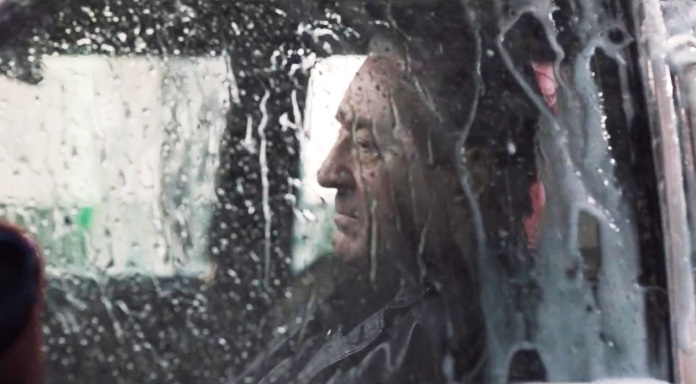
Director: Martin Scorsese
Screenwriter: Steven Zaillian
By Roderick Heath
And then, more time had passed than anyone realised, and suddenly things we thought perpetual are lost, and the age and its titans that stood in authority became another dusty annal.
The Irishman, directed by Martin Scorsese, now aged 77, stands self-evidently as a work both extending and encompassing a key portion of Scorsese’s legacy, his beloved and perpetually influential mafia movies. The Irishman reunites the director with three actors long connected with his cinema, Robert De Niro, Joe Pesci, and Harvey Keitel, as well as bringing in a fresh young whippersnapper named Al Pacino. The sharp pang of recognised mortality inherent in The Irishman is given a special cruelty by the way Scorsese’s cinema has long seemed, even in its most contemplative and rarefied moods, like American virility incarnate. The clamour of New York streets, the whiplash effects of urban life’s furore and the human organism in contending with it, the buzz of an era bombarded with cinema and television and advertising, written into the textures of Scorsese’s famous alternations of filmic technique, whip-pans and racing dolly shots colliding with freeze-frames and languorous slow-motion: Scorsese’s aesthetic encephalograph. The Irishman has been described by many as a terminus for the gangster movie. That’s fair in some ways, dealing as it does with a basic and essential matter very often ignored in the genre, what happens when gangsters are lucky enough to get old and die, as well as simply recording a moment when a genre’s stars and a most esteemed creator are facing the end of the road, however distant still.

But of course, movies set amongst hoodlums and lowlifes are still pretty common, for Scorsese’s bastard artistic children are plentiful and likely to populate the cinematic landscape for a good while yet. What new tricks could the old dog still have to teach? The Irishman answers that question incidentally as it adapts a book by Charles Brandt, recounting the life story of Frank Sheeran. As biography it includes inarguable factual details, like the time Sheeran spent as a World War II soldier, truck driver, and Teamster official jailed for 13 years for racketeering, blended with assertions and conjecture about Sheeran’s involvement with organised crime, most vitally the claim he personally killed Jimmy Hoffa, the legendary former head of the Teamsters union, who vanished in 1975. The tales in Brandt’s book have been disputed, but the appeal to a filmmaker like Scorsese, over and above the inherent drama in such a story, lies in the way Sheeran claims to have grazed against the mechanics of power underlying American history in the mid-twentieth century, and indeed have been part of the mechanism, the finger that pulled triggers but never the levers. The Irishman becomes, amongst many achievements, a unified field theory in regards to the concerns of Hollywood’s New Wave filmmakers, wrestling with the waning memory of a certain age in political and social life, as well as that cinematic era.

And yet The Irishman is also a project that sees Scorsese negotiating with very contemporary aspects of the moviemaking scene, produced by online streaming giant Netflix and exploiting all the possibilities opened up by such a backer in making a film without compromise, and employing a cutting edge special effects technique, using digital processes to make his lead actors appear younger in sequences depicting their characters in their prime. It’s Scorsese’s longest film to date, a veritable epic in theme and scope even whilst essentially remaining an interpersonal story, arriving as a roughly hemispheric work. The first half, recounting Sheeran’s early encounters with the potentates of the underworld and evolution from scam-running truck driver to hitman and union boss, broadly reproduces the detail-obsessed and gregariously explanatory style of Scorsese’s previous based-on-fact mafia life tales, Goodfellas (1990) and Casino (1995), if rendered in a much cooler, less compulsive manner. The second half mimics the processes of ageing, slowing down until finally reaching a point of impotent and stranded pathos, ticking off fate-making moments of choice and consequence, contending with the ultimate consequences and meanings of a man’s life actions.

If The Irishman’s tone and sense of mortal and moral irony suggests Scorsese’s tribute to Stanley Kubrick’s Barry Lyndon (1975), the famous epigraph of which Scorsese reiterates in direct and pungent terms, the method is more reminiscent of Sergei Eisenstein’s Ivan the Terrible Parts I & II (1944-58), as an expansive and surveying first portion sets up a second that proves a dark and immediate personal drama about power and betrayal. The Irishman’s narrative revolves around what seems initially a scarcely notable vignette, with Sheeran and his friend, associate, and boss Russell Bufalino (Pesci), a cool, wary potentate of the Philadelphia mob with great resources of invisible yet definite power, and their wives Irene Sheeran (Stephanie Kurtzuba) and Carrie Bufalino (Kathrine Narducci) striking out on a road trip on the way to attend the wedding of the daughter of Russell’s lawyer brother Bill (Ray Romano) in 1975. Sheeran’s voiceover narration readily concedes there’s a definite pretext to this trip, as Russell wants to collect various debts along the way. But the peculiarly pregnant, tense mood of the journey betrays something else in the offing, a hidden source of tension and expectation, and of course when it comes into focus the implications are terrible. The road trip accidentally doubles as a trip down memory lane, as they pass the scene where Sheeran and Russell first actually met, when Russell helped the young truck driver when he was pulled over with mechanical trouble, sparking an account of their adventures in racketeering.
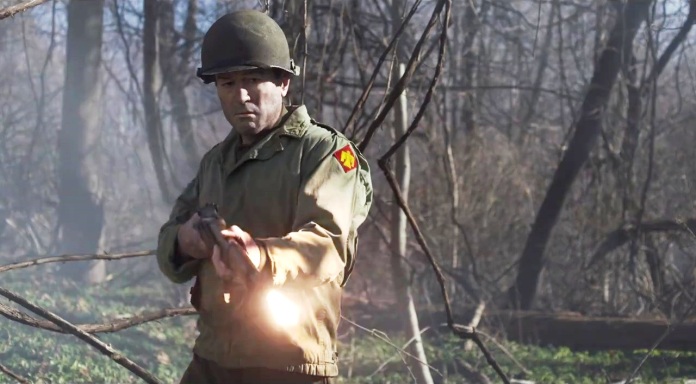
The Irishman returns to a motif Scorsese touched on in Shutter Island (2010) in contemplating the mental landscape of the so-called greatest generation of servicemen returned from World War II, men playing at fitting into a suburban world whilst invested with the skills and reflexes of soldiers, all too aware, with niggling import, how thin the membrane between settled life and chaos can be. Sheeran recounts the pathetic details of shooting German POWs with nonchalance, an experience he describes as teaching him to simply accept life and death with an almost Buddhist indifference, only to make sure to be on the right end of the gun. This experience, at once brutalising and transfiguring, proves to have armed Sheeran with not just a skill set but a mindset as well, one that makes him useful to men like the Bufalinos and their associates, including Angelo Bruno (Keitel), and ‘Fat’ Tony Salerno (Domenick Lombardozzi). Sheeran gains his first contacts in the underworld via the lower-ranking Felix ‘Skinny Razor’ DiTullio (Bobby Cannavale), by letting him substitute the high-quality meat Sheeran transports for his restaurant. When a load of meat he’s carrying vanishes before he can steal it himself, Sheeran is prosecuted for the theft. Bill Bufalino successfully defends his case, although he gets sacked from his driving job. After proving himself adept at debt collecting for DiTullio, he gains a more definite connection to Russell and Angelo, who sit in mandarin judgement upon representatives of a tragically unwise world.
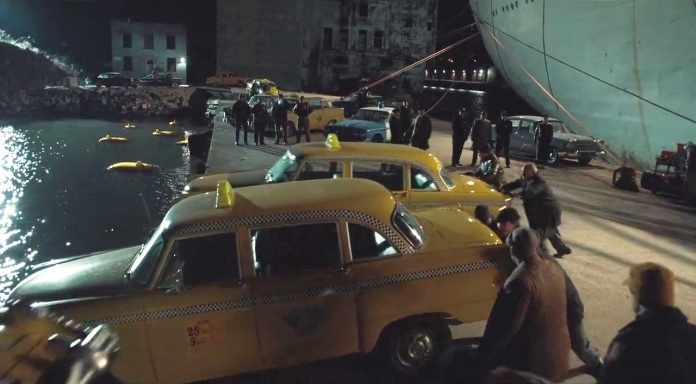
As in Goodfellas and Casino, Sheeran’s narrative expostulates the arts of gangsterdom in a succession of illustrative vignettes, as Sheeran begins to make himself reliable with his army-instilled smarts for sabotage and demolition, making him handy at wiping out rivals’ sources of income and power. Such gifts are illustrated in sequences touched with a sense of the ridiculous, as when Sheeran and some other mobsters try to wipe out an opponent’s taxi fleet by laboriously pushing all the cars into the harbour before Sheeran suggests less arduous means. When he’s hired by a laundry boss Whispers DiTullio (Paul Herman) to destroy a rival laundry only to be brought before Angelo who partly owns the rival, Sheeran is obligated to make amends and shoots Whispers in the face, kicking off his new career as a hitman, or, in coded parlance, a man who “paints houses” with blood. Some of the blackly comic hue Scorsese’s long been able to tease out of such grim situations manifests here as Sheeran notes the building arsenal of used weapons collecting on a river bottom under a bridge popular with folk in his line of work to toss away their used guns. Scorsese avoids the adrenalized fervour of his earlier films, however. For one thing, Frank Sheeran is a different creature to guys like Henry Hill or even Jordan Belfort, who delighted in their status as men apart, challenging law and fate with bravura even as they proved much less tough and canny than they wished to think. Sheeran rather fancies himself as a suburban husband and father with an unusual occupation: the circumstances that eventually make him a hitman stem from the need to feed his growing family.
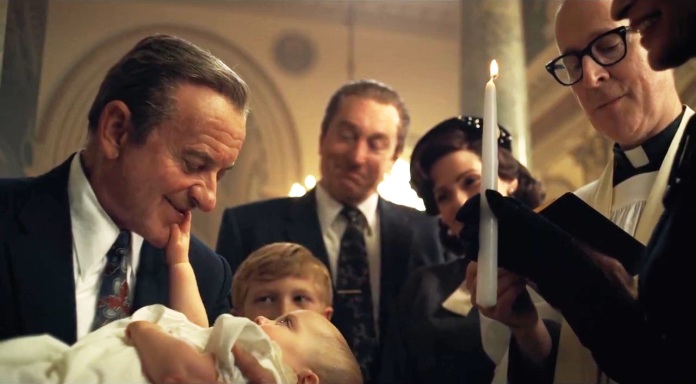
Part of what made Scorsese’s canonical gangster films vibrant was the way they offered innately interesting prisms through which to encompass other, more quotidian things difficult to make popular movies about. Friendships, troubled marriages, domestic violence, gender roles, the structure of civic life and the circuits of power that often hide in plain sight. One reason Scorsese has long seemed to have a specific affinity for the genre, to a degree that tends to drown out perception of his varied oeuvre, is because the gangster in his eyes simply represents ordinary people in extremis, bound by peculiar loyalties of family and immediate community, balancing attempts to retain certain ideals whilst contending with a cruel and corrupting world. Rodrigo Prieto’s photography, with a muted, greyish colour palette, gives the most immediate visual clue to the way The Irishman disassembles the template of Scorsese’s earlier gangster works, contrasting their lush, pulpy hues and baroque evocations in favour of something chillier, more remorseless, like the cancer that eats up the flesh and bones of these old bastards in the end.
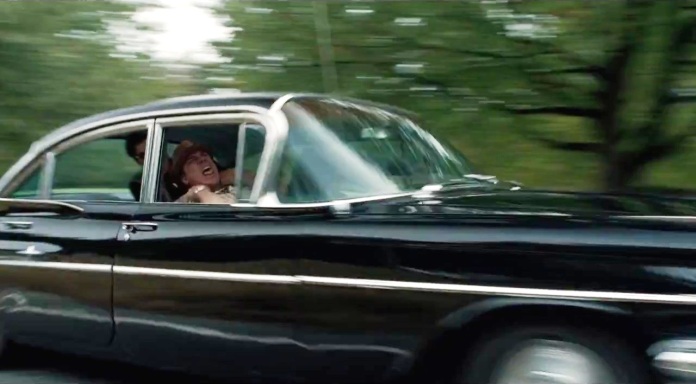
Another vital pivot in Sheeran’s life comes when Russell sets up the opportunity to become Hoffa’s enforcer, some hard muscle to back up Hoffa’s battles with rivals and powerbrokers. Sheeran’s first conversation with Hoffa over the phone sees De Niro register with beautiful subtlety the minuscule moment of shock as Sheeran realises Hoffa speaks the rarefied language of mob euphemism, conversant in the harshest facts of such life. But Hoffa manages to retain an avuncular glamour, a sense of righteousness even when swimming with human piranha, through seeming like a general engaged in a long guerrilla war, and he also crucially reaches out to Sheeran as “a brother of mine,” that is, a Teamster. Hoffa isn’t wrong to surround himself with hard men, with lieutenants nominally under his control like Anthony ‘Tony Pro’ Provenzano (Stephen Graham). Sheeran recounts how Pro had a rival underling garrotted in a car, cueing one of the film’s most startling visual flourishes, as the murder is glimpsed as the car moves by a moving camera, yawing mouth in silent scream and struggling bodies glimpsed in a flash and then gone. Pro is just one of many creeps and thugs who parasite off the Teamster organisation, a union built to resist the violent resistance to organised labour from management, but which has required and rewarded mob support to do so. Tension builds between Hoffa and his underworld contacts however as he tries to prevent the Teamster union fund, which bankrolled their casino projects, from devolving entirely into a ready cash pool for wiseguys. When a government investigation of Hoffa sees him imprisoned, the mob becomes more inclined to see the union go on being run by more pliable figures, like Tony Pro and Frank Fitzsimmons (Gary Basaraba).
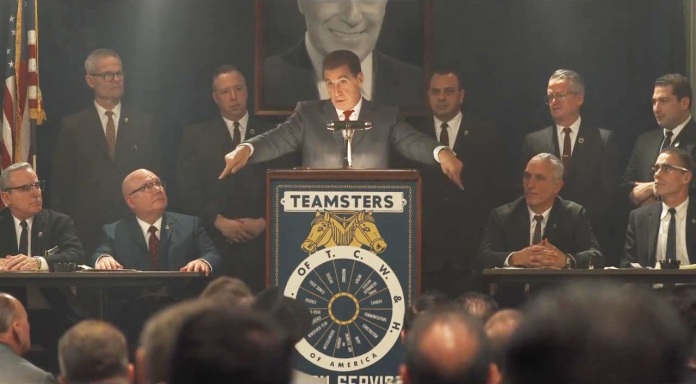
Like an updated version of the same analysis in Gangs of New York (2002), Scorsese considers the tribalism of politics and gangland as they form mutually parasitical relationship through their symmetry of outlook and method, disconnected from the real musculature of the workers whose ambitions and desires fuel their empires. Hoffa’s story has already been told comprehensively on film, in Danny DeVito’s overblown but fascinating Hoffa (1992), which rendered his life as an outsized romantic epic and elegy, in complete contrast to Scorsese’s dolorous and nitpicking realism. Hoffa was upfront in exploring the way Hoffa turned to the mafia for support to counter the overt and unsubtle brutality wielded by big business, where here this aspect is more implied and seen as part of an inseparable organism: wherever human energy is turned, and money’s involved, reefs of strange coral grow, and sharks come to live. The great swathe of The Irishman’s plot encompasses titanic figures like John F. Kennedy and his brother Robert (Jack Huston), whose vendetta-like pursuit of Hoffa drives the union boss to distraction, and finally overt acts of petty defiance like refusing to have the Teamster flag lowered after John’s assassination, whilst it’s heavily suggested the mob arranged the assassination in revenge for the Kennedys turning on them after they helped John’s election.

Such history also grazes minor yet noteworthy supporting players like David Ferrie (Louis Vanaria), interlocutor for the Mafia support for Cuban exiles trying to retake their nation from Castro, and E. Howard Hunt (Daniel Jenkins), CIA agent and eventual Nixon henchman infamous for his role in Watergate, both of whom Sheeran meets delivering equipment to the Cubans. Sheeran’s encounters with such people illuminate in flashes the great puzzle of power Sheeran perceives without really comprehending. They also contain Scorsese’s winking acknowledgement of the way the film encompasses cinematic as well as political history, for Pesci played Ferrie in Stone’s JFK (1991), whilst the personages and events the film touches on have provided bone marrow for a host of serious modern American movies. Such encounters are nonetheless laced with a droll sense of individual ridiculousness and everyday farcicality contaminating all facades and postures. Hunt gets upset when he thinks Sheeran is staring at his infamously big ears. Hoffa’s unwitting ride to his end, a moment of solemn and skittish tension, is tainted by the smell and run-off of a fish his adopted son Chuckie O’Brien (Jesse Plemons) dropped off beforehand for a friend, taunting all the men present with the reek of ludicrous fortune and imminent mortality. Sheeran’s proximity to Hoffa and the generational struggle he represents is the most concrete and meaningful of his brushes with renown, and even sees him write a page of history.

And yet Sheeran’s presence is actually defined by his absence, his being the incarnation of impersonal power, his carefully maintained readiness to be erased the key to his success as a killer and functionary. There’s an aspect of the self-mortifying and self-annihilating in Sheeran’s makeup, only purveyed for worldly rather than spiritual ends. Hoffa keeps him in his hotel room so his visit to the city for strongarming is completely without record, a trick that’s eventually turned on Hoffa as it’s revealed the true purpose for Sheeran and Russell’s road trip in 1975 is to set up a situation where Sheeran can be flown to Detroit to kill Hoffa. His talents as a killer demand taking some real risks, particularly when he’s sent to take out Joseph ‘Crazy Joe’ Gallo (Sebastian Maniscalco), a strutting, defiant figure of the underworld who happily ignores its laws as much as the straight world’s and who’s had a potentially difficult Teamster boss killed during a rally. Scorsese nods back to the gun purchasing scene in Taxi Driver (1976) as Sheeran selects the ideal weapons for the attack and considers how to pull it off with method. Sheeran elects to kill Gallo in a restaurant, avoiding gunning down his family members about him whilst taking out his bodyguard, before chasing Gallo out to the sidewalk to deliver the coup-de-grace as he’s sprawled on the concrete. This scene captures Sheeran’s abilities as a hitman at zenith, as well as illustrating his personal myth, seeing himself as a good guy in terms of the world he lives in, a heroic gunslinger eliminating fools and scumbags and sparing the innocent. It’s a mystique eventually stripped from him in the rudest possible manner.

Although hardly a repudiation of his bravura stylistic flourishes, The Irishman sees Scorsese and his ever-ingenious editor Thelma Schoonmaker delivering a sinuous and measured work of high style. An early shot ushering the viewer/camera down the corridors of the nursing home Sheeran’s exiled to in his dimming days has the quality of a visitation by a reluctant but curious acquaintance; when this shot is repeated close to the end, it has a lacerating effect as now it’s clear that when the camera abandons Sheeran he is left in utter solitude, deserted by all he once claimed as friends and family. Scorsese repeatedly interpolates sequences shot in extreme slow motion, in one case in portraying percussive violence as Gallo’s goon shoots the Teamster official, bullets puncturing his flesh in spurts of red blood whilst hands desperately wrap about the assassin, but in each case with a sense of languorous absurdity even when describing tragedy, like the survey of seemingly mundane but despicable visages at the wedding after Hoffa’s killing: the wistfully twanging tones of a guitar cover of ‘Blue Moon’ and some doo-wop giving such scenes with a sardonic quality, at once melancholy and mocking. Throughout the film Scorsese puts up titles identifying various characters with their nicknames and the date and manner of their death, almost only violent. In the film’s slyest joke, one man is blessed with a title describing him as “well-liked by all, died of natural causes.”
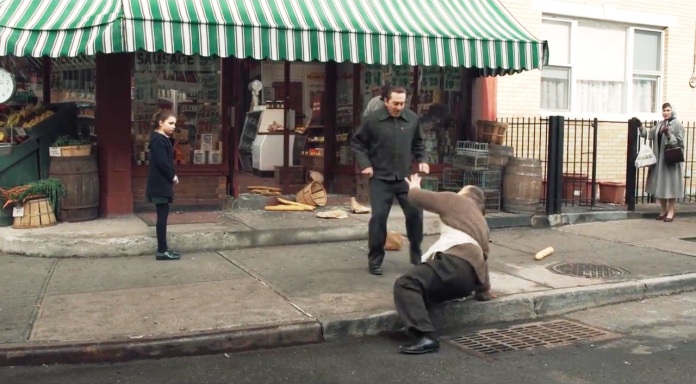
The cumulative effect of this device is to emphasise not just the incredible brutality of the mob world around Sheehan but also his ultimate luck, which might not be luck at all, in outliving all of them; suspense is removed from the equation, and instead we’re made to understand Sheeran as a man living in a city of memory crowded with ghosts. The mob community, one that eats its own, is a perverse family that has its deep rituals of belonging and expulsion. But the rubbing out – erasure – of its members is reproduced in terms of actual family as Sheeran secures his position but with consequences. Of his four daughters, Peggy, growing from a small girl (Lucy Gallina) to a middle-aged woman (Anna Paquin), matures as the mostly silent but incessantly aware ledger of culpability. She regards Russell with suspicion, knowing him for the monstrosity he is, and remains wary of her father ever since witnessing in childhood the spectacle of him beating up a grocery store owner who treated her brusquely, an act that left her feeling less like the well-guarded princess than an unwitting bringer of violence and horror. Peggy’s gravitation to Hoffa, even idolisation of him gives special sting to the way Hoffa embodies for Sheeran a more idealised version of himself, a man with feet planted in the mud and bloodied knuckles but with the stature of a working-class gladiator turned statesman.
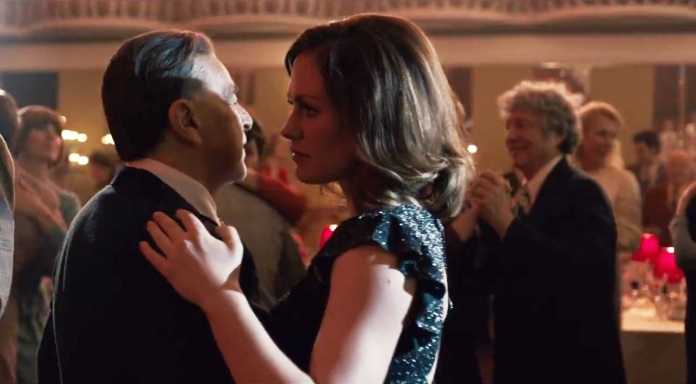
The shift of The Irishman from case study review to something more intimate and tragic is managed over the course of a central sequence where Sheeran’s tenure as a Teamster Local boss is celebrated. Hoffa is present, out of jail and pursuing his utter determination to win back “his” union from Fitzgerald, Pro, and the mob heavyweights who want to maintain the new status quo. Hoffa glares daggers at Russell and Salerno whilst sawing up his steak, and carefully fends off Sheeran’s mediating warnings about giving up, insisting with simple assurance that for him abandoning such a cause, so deeply infused with his sense of being and mission, would be tantamount to dying in itself. Peggy watches the play of glances and conversation as she dances, long used to divining through such tells of language and posture. Sheeran is ennobled when Russell gives him a ring that signals his induction into the innermost circle of the mob along with Russell himself and Salerno, a gesture that indicates permanency and security in terms of that family, but which soon proves to actually be a nomination and bribe, as Sheeran is being commissioned without realising to be Hoffa’s assassin.

The vein of pitch black comedy, blended with a forlorn sense of human vileness, is particularly icy here as Sheeran is essentially wedded to Russell via the exchange of rings, a gesture that contrasts in fascinating ways both men’s relationships with their nominal wives and families. Russell is married to a princess of mob royalty, a detail noted as it makes Russell seem for all his gathered strength like someone who just lucked out and married the boss’s daughter, whilst Sheeran almost casually seems to swap his first wife Mary (Aleksa Palladino) for his second, a little like getting a car upgrade. Hoffa’s wife Josephine (Welker White), who gets fired from her Teamster bureaucratic job in the escalating tit-for-tat, winces and imagines a car bomb blowing her to smithereens as she starts her car before the engine roars calmly to life, just another moment in the life of a foot soldier in a game of spousal ego. Late in the film Sheeran ruminates with tragic sting on how another car, one he loved, became responsible for his imprisonment. The men in The Irishman, at least until it’s too late, tend to adopt a fiercer sense of loyalty to the measures of their social status than their human attachments, from Hoffa’s obsession with “his” union to Pro’s anger at losing his Teamster pension despite being already being rich through to that car of Sheeran’s, his personal cross with Corinthian leather seats.

One of the wisest decisions Scorsese made in tackling The Irishman, possibly even the reason he made it, was also one of costliest and most troublesome, in offering a movie that serves as a grace note not only for Scorsese’s career but for his stars. Though he’ll surely make more movies, perhaps many more if he keeps at it like Clint Eastwood, The Irishman relies in a manner reminiscent of something like Sam Peckinpah’s Ride the High Country (1962) on emotional association with its stars and the sense of an era ending. Scorsese first worked with Keitel on his own debut feature Who’s That Knocking At My Door? (1967), and his associations with De Niro and Pesci, stars of several of his best regarded works, seem virtually umbilical. Scorsese spent a lot of time and effort on the de-ageing effects even as the stiff and angular movements of the actors, as well as the often plastic look of the effects, betray reality. It’s a more convincing approach than using make-up probably would have been for actors in their seventies, but the artificiality is still patent. In practice it’s clearly just a theatrical nicety, not trying to fool the audience but negotiate with our knowing in a way that Scorsese couldn’t have managed if he’d cast other actors to play his protagonists when young as is the usual practice. Scorsese needs the sense of continuity, wants us to perceive the corporeal reality of old men lurking within facsimiles of young, potent bucks, in a tale where what age does to self-perception is a key aspect of the drama as well as artistic nostalgia. The quality of the mask-like in the effects underscores Peggy’s keen capacity to penetrate such veneers, and time just as assiduously uncovers the face men carve for themselves.
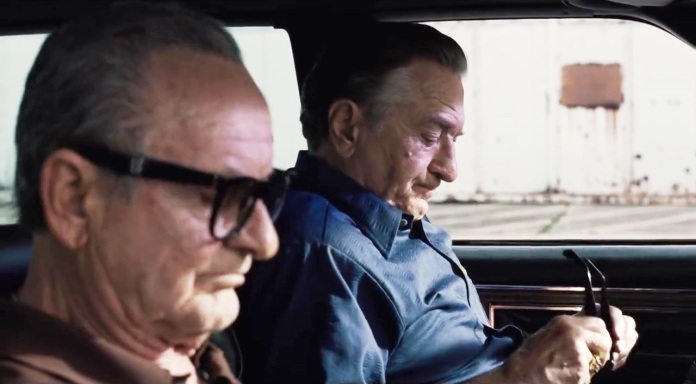
Hoffa conceives time as a literal form of wealth, a notion that provides both a thematic thesis – everyone’s time is running out – and also essential characterisation, as Hoffa’s anger is stoked by nothing quite so much as being made to wait, in part because he knows that waiting is something you only do for someone who presumes to have control over you. Which is why Pro calculatedly infuriates him by turning up late to a meeting, adding fuel to their feud. Pacino, ironically making his first appearance in a Scorsese film despite being very much another Italian-American product of 1960s New York’s cultural vitality and long associated with gangster films, is particularly well-cast not only for his capacity to project potent, larger-than-life charisma but also embodying in Hoffa a being who, whilst capable of speaking over the gap, nonetheless inhabits a slightly different continent to the gangsters, a man corrupt, compromised, but proud, not cynical in his authority even when cynical in many of his actions. Pesci by contrast is intriguingly cast as the most contained and calm of the major characters here after playing eruptive firebrands for Scorsese in the past, his Bufalino charged with terseness edging into easily stirred disgust, as he deals people who can’t work to the very specific rule their world demands, like an aged priest with unruly seminarians. One of the most arresting vignettes in The Irishman is also one of its most casual, as Russell orders Sheeran to hand over his sunglasses before he boards a plane to go kill Hoffa. Russell knows very well that the sunglasses are part of a killer’s uniform and shield, where he knows Sheeran needs the appearance of complete simplicity to pull off the hit, and moreover the discipline imbued by not retaining such a shield. Treachery must be entirely honest.

De Niro’s specific brilliance, in a different key again from his two great costars, manifests in playing a man who feels no particular emotional urgency until it’s far too late for him to do anything about it. This reckoning comes in two great, mirroring moments, first as he regards Russell in silent grief and reproach even as he also plainly acquiesces to his command to kill Hoffa, and then later as he struggles to maintain a feined veneer of bewildered concern through a conversation with his family over Hoffa’s vanishing, before calling Josephine Hoffa to offer reassurances. The film’s heightened commentary on paternalistic values, where old men’s capacity to make conversation is a very obvious marker of their power and various characters ultimately reveal their foolishness and impotence by talking out of turn or too long, crystallises here as Peggy, who has noticed everything whilst adhering to the rule of being seen but not heard, rips off her father’s façade with a few pointed words, “Why?” the question that registers like the point of an ice axe into a glacier. Sheeran makes his call, an action of duplicity and false hope he’s still quietly hating himself for making as he waits around to die decades later: “What kind of man makes a call like that?” he asks of an oblivious priest seeking his confession in the nursing home.

The most fundamental thread of Scorsese’s cinema has been the hunt for spiritual and aesthetic clarity in desperate conflict not just with the necessities of existence within a society but also with physical and emotional hungers that lead in the opposite direction from sainthood, even whilst stemming from the same impulses. Scorsese knows about such things; he took on Raging Bull (1980) as a project after being hospitalised for a cocaine overdose, and that film’s alternations of dreamy meditation and raw savagery have infused his mature oeuvre ever since. The Irishman follows Scorsese’s masterful study of cultural and religious clash, Silence (2016). Where that film seemed a capstone on a loose trilogy studying belief after The Last Temptation of Christ (1988) and Kundun (1997), The Irishman rounds out Scorsese’s study of mafia lore in Goodfellas and Casino, chasing their concerns to one logical end. The unexpected quality of The Irishman is that it also unites the two bodies of work. Scorsese returns to the figuration of Judas and Jesus Scorsese wrestled with so controversially on The Last Temptation of Christ in Sheeran’s treachery towards Hoffa. This comes with an inherent sense of irony – no-one here is exactly Jesus – whilst extending Silence’s contention with devotion and betrayal, the costs of adhering to a faith, with inverted propositions, and like so many of Scorsese’s films it contends with a character who eventually faces the essential situation of being left alone to do battle, Jacob-like, with their contending angels and devils.

The ideals of religious faith, humane and yet eternally defined by individual conscience, high-flown, transcendental, necessarily defined ultimately by a person’s solitary confrontation with their conception of eternity, have always warred in Scorsese’s vision with a different brand of faith, a social devotion defined by communal ties, hierarchy, expectation, and ruthless punishment for deviation. Religious faith, which in Scorsese often bleeds into other faiths, like labour organising in Boxcar Bertha (1971) as well as in The Irishman, contends with social faith in direct contrast: religious faith is punishment of self where social faith is punishment of others. Father Rodrigues in Silence suffered just as much and met his end just as solitary and battered as Sheeran, but his retained grip on faith into the grave signalled his most vital stem of being, no matter how tortured, retained a sense of worthiness in his life mission. By contrast Sheehan is left by the end of The Irishman entirely stripped of any illusion his choices have ultimately been worth the cost. The Irishman treads close to proving a classical winter’s tale as Shakespeare might have recognised it, even as it finally refuses to become such a tale. Those are supposed to be about conciliation and natural cycles, stories where the bite of the frigid season matches the gnawing proximity of death and the necessity of making peace to facilitate rebirth. The Irishman is about the consequences of rudely assaulting nature, and instead becomes something far more like King Lear, a tragedy where a once-ferocious king is left bereft and pitiful and exiled from home and kin because of the long, lingering memory of his own lessons.

Hoffa’s actual death nimbly turns from deadpan realism, as Sheeran shoots him in the head in an awkward and rushed jumble of motion, to a precisely composed renaissance pieta, as Sheeran leaves the arranged corpse and gun lying in the foyer of an empty house. Scorsese lingers on the sight after Sheeran leaves, the weight not simply of violence and crime but of dreadful absence, the negation of Hoffa’s presence and will, forces that compelled the world. The hit excises a roadblock to easy business but also echoes as an act of violence that consumes the men who committed it. Sheeran is forever excommunicated by Peggy, refusing to speak to him again even as he shambles after her in withered age in a bank where she works, whilst destabilisation vibrates through the mob world, with authorities prosecuting and jailing everyone they can, including Sheeran and Russell. Their figurative marriage becomes more like a real one as they’re left only with each-other in a cold and cheerless old age, withering within prison walls, two men who quietly despise each-other for the compromises forced and the implied lack of forgiveness in return, chained together in a caricature of amity into the halls of prison and then the grave.
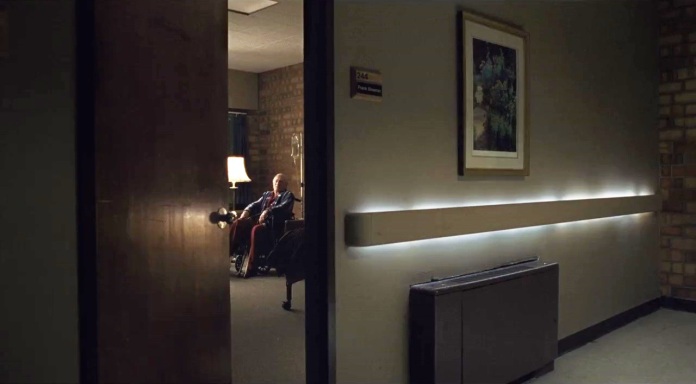
The viewer must watch with both a touch of scorn and half-willing sympathy as Russell, dying, reveals he’s turned to religion as he’s pushed away in his wheelchair for treatment, as if he’s found a way to mollify the big boss. No major American director has dealt so sharply with imminent old age, the reduction of the human form and mind by the entirely natural predation of ageing, although in taking up such a theme in what’s nominally supposed to be a true crime thriller recalls Eastwood’s similar evocation in J. Edgar (2011). Sheeran’s corrosive experience of solitude and humiliation even after being released from prison sees him fending off two calls for purgation by confession, from the priest (Jonathan Morris) and federal agents, whilst he picks out coffins and resting places, still hunting a last echo of worldly status even into the grave. But the framing suggests Sheeran is confessing to someone, perhaps the audience, a surrogate for Brandt, a craned ear hungry for forbidden lore. All these legends lose their immediate meaning as their actors die off, even as the labour they’ve been part of, equated with both the society they comprised and the movie they appear in, persists, carrying lessons that cut many ways for those who follow. Sheeran recounting his story is one last attempt to leave a certain mark, to give experience any form of meaning. Scorsese grants him no absolution, but does offer a small consolation.

Wonderful review again, Roderick!
“Rodrigo Prieto’s photography, with a muted, greyish colour palette, gives the most immediate visual clue to the way The Irishman disassembles the template of Scorsese’s earlier gangster works, contrasting their lush, pulpy hues and baroque evocations in favour of something chillier, more remorseless, like the cancer that eats up the flesh and bones of these old bastards in the end.”
Great point!
LikeLike
Hi Andre. Yes, I think Scorsese using Prieto as his DP has been a major signifier of his late aesthetic. Prieto can do lush colours but the textures on Scorsese’s last three films have all been measured, with a strong sense of the physical presence of actors. Silence wouldn’t have worked without that awareness, nor would this one.
LikeLiked by 1 person
Great review 🙂 I agree with every single thing you wrote here. Scorsese’s use of The Five Satins “In the Still of the Night” in the beginning and end come off as truly inspired. Also, I think a credible argument can be made that The Irishman stands out as the most catholic of his gangster films; regarding not only Frank Sheeran’s religious background, but also his scenes with that priest near the end of the film.
This is a great blog you have and keep up the great work as always 🙂
LikeLike
Hi John, welcome to my nightmare. Most Catholic gangster movie? Maybe, although Abel Ferrara’s The Funeral might still be edging ahead in that regard. It’s been a strong visual and thematic overtone in the genre since The Godfather.
LikeLiked by 1 person
Let me correct myself, I did not call The Irishman the most catholic gangster film ever made, I said it was the most thematically catholic of his more expansive crime films (Goodfellas, Casino, Gangs of New York, The Departed and this one, The Irishman). Mean Streets was a smaller scaled film, but If we were to hold a contest of which Scorsese crime picture (expansive or small scaled) were the most catholic Mean Streets would probably be number one and The Irishman would probably be number 2, but that is just me.
P.S. I love The Irishman so much that I watched it four times already on Netflix 🙂
LikeLike
Correction: I mean to say “the most thematically catholic of Scorsese’s more expansive crime films” 🙂
LikeLike
Watched it (finally) this week over two nights. Your review clarified a few things for me, like the sunglasses bit, I didn’t pick up on the reason for that at all. Also lost track of some of the characters, or never picked up on who a few of them were, think I’d need another pass at it to get it all.
The only thing that I wasn’t sold on was Pacino’s interpretation of the Hoffa character. Maybe that’s accurate, but Pacino struck me as playing Hoffa as almost eccentric, and my feeling is anyone who was the head of the teamsters was very tough and forceful, and I didn’t get that from Pacino. in one scene I even had a flashback to Big Boy Caprice. Great review, and really a first rate movie.
LikeLike
Hi Patrick. I liked Pacino’s performance a lot, and I felt Scorsese was trying to use it to make a point that echoes throughout the film, about that gap between the way people seem in their headline functions — it’s there also in something like the moment with Howard “Big Ears” Hunt — and the people they really are. The scene where Hoffa chewed out his staff and then came out to mollify Sheeran was some sublime comedy on that note. I didn’t notice any Capricisms although it’s been a long time since I saw Dick Tracy. That said, I also love Jack Nicholson’s more fiery, old-school fighter take in Hoffa; the scene where he was so angry he overtly told Assante’s gangster he wanted him to kill Fitz perhaps summarised the whole problem with the man in a thumbnail where this needs hours to do the same thing. Anyway, glad you liked the piece and the movie.
LikeLike
I haven’t seen “Hoffa” since whatever year it was released, about all I remember is it just didn’t have much spark to it, but I might try to find it and catch a few minutes of it now just to see Nicholson as Hoffa. I’m sure if there’s one thing he brought to the role it would be intensity.
LikeLike
Yes, he certainly does; in fact it might be my favourite post-1990 performance of his. I’m a mild fan of the film, myself. Mamet’s script is terrific and De Vito’s direction, whilst overdone, has a lot of flavour.
LikeLike